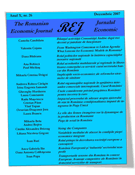Abstract:
Nobel Laureates with their contributions to the development of the theory of general equilibrium have enabled this theory to be one of the most important for theoretical and practical analysis of the overall economy and the efficient use of economic resources.
Results of the research showing that contributions of Nobel Laureates in the economy belong to two main frameworks of development of the general equilibrium theory: one was the mathematical model of general equilibrium developed by John R. Hicks (1939), Kenneth J.Arrow (1951) and Gerard Debreu (1954) and second frames of general equilibrium belongs to Paul A. Samuelson (1958).
To highlight the contributions of these Nobel laureates in the development of the theory of general equilibrium have been selected and are presented in the paper some views, estimates and assumptions that have contributed not only in solving concrete problems, but also to the development of economic science in general.
Their works represent a synthesis of theoretical and practical aspects of treatment of general equilibrium which are the starting point for further research in this field.
